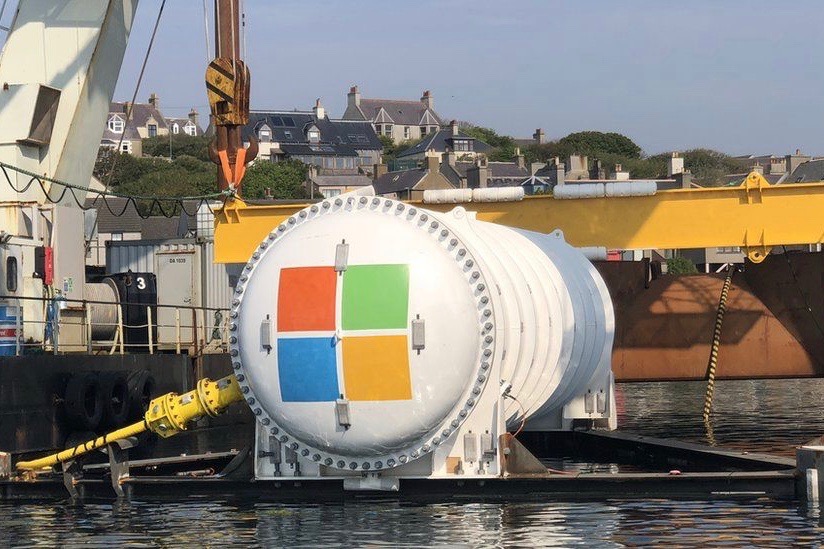Published on the 02/09/2022 | Written by Heather Wright

Subsea Cloud claims commercial launch by year end…
The first US commercial underwater data centre could be up and running by the end of this year – but it won’t be Microsoft, with its Project Natick, leading the way.
Instead, a US startup, Subsea Cloud, claims its Jules Verne Pod will be installed off Washington State by year end.
“By 2030, our pods will be installed near every coastal city.”
The six-metre Jules Verne container will accomodate 800 servers, nine metres under water. Subsea Cloud claims it can reduce latency by up to 98 percent and reduce power consumption and emissions by 40 percent, claiming each pod can stop as much as 750 tons of carbon being deployed per year.
In June, Subsea Cloud founder Maxie Reynolds said the 14-month old company was also working with Singapore government officials and local companies to deploy the subsea pods in the region as well. The company also has plans for a pod in the Gulf of Mexico and provisional plans for a North Sea offering.
Subsea’s planned deployments – and others in China – come at a time of increasing pressure on data centres. Both Microsoft and Amazon have had their plans for new data centres in Ireland quashed amid concerns about power shortages and supplies. Equinix is also understood to have been impacted with state-owned electricity provider EirGrid putting a hold on any new data centre connections to the grid until 2028.
Meanwhile extreme weather in Europe saw several data centres taken out of action recently as temperatures soared.
Microsoft has already shown the feasibility of underwater data centres. Back in late 2020 it released the findings from its second phase of Project Natick, its two year underwater data centre test, saying the test showed underwater data centres were reliable – Microsoft claimed eight times more reliable than those on land – practical and environmentally sustainably.
Microsoft had loaded 12 racks containing 864 servers into a 12.2m container before dropping it in around 36 metres of water off the Orkney Islands in Scotland in 2018. It followed an earlier test which served some Azure workloads from a small 2.4m cylinder dropped into 9m of water off the US’ Pacific Coast.
Microsoft appeared bullish about an underwater future. “With the retrieval and preliminary analysis of the phase 2 vessel, we’ve now confirmed that not only can we successfully deploy, operate, and scale an undersea data centre, but also that this more sustainable approach actually improves the performance and reliability of the datacenter when compared to land,” the company said.
“Project Natick had 1/8th the failure rate of land data centres. Not only is a greener future possible, but it is economically practical.”
The atmosphere of nitrogen – less corrosive than oxygen – and the absence of people to jostle components, were believed to be key factors for that greater reliability. Uptime Institute has said human error accounts for around 70 percent of data centre problems.
Images surfaced of a third generation offering, suggesting it would include 12 data centre cylinders held in place in a 300m long steel frame.
But then all went quiet. Despite the hype around Project Natick, and Microsoft’s claims of success, there appears to have been little action since with the Project Natick website still reporting that ‘we are still reviewing the data’.
China, meanwhile, has been more active. A four-rack test vessel was launched in early 2021 in Guangdong by Beijing Highlander.
By late 20221, work reportedly began on the world’s first commercial underwater data centre located Hainan Island and part of the Hainan Free Trade Port initiative. That US$879 million project will feature up to 100 pressure vessels, due to launch in three phases.
Several other underwater data centre projects are also underway in China, including one in the Yangtze River Delta.
Subsea claims the underwater facilities cost 90 percent less to make versus their land-based counterparts, due largely to their smaller bill of materials, reduced maintenance and less deployment complexities – read consent and permit costs.
Fifty percent of the world’s population lives within 200km of the ocean, adding the promise of potentially faster connections for many.
Deployment time for mass-produced capsules would also be significantly faster than building land-based data centres – weeks instead of years.
But there are also concerns including around security, power, and the corrosive and logistical constraints of undersea environments. Microsoft’s offering came with a planned maintenance free operation period of up to five years. Subsea Cloud says it can retrieve pods within 20 minutes to two hours with servers and other gear accessible soon after in the event of any failures. But getting to the site, isn’t factored into that, and Reynolds says for most projects a ship is in a 12 hour sailing radius – but it will only have ships on standby when it has 20 pods.
Others also raise concerns about the potential negative environmental impacts of warming the waters around the pods, though Microsoft did tout harvesting electricity from the movement of seawater, so no new energy was added and there was no overall heating.
Certainly, other big name data centre operators, including Amazon and Google, don’t seem to be keen to get their feet wet with underwater data centres.
Subsea Cloud is un-daunted.
“By 2030, our pods will be installed near every coastal city, powered completely by renewables and benefiting the entire ecosystem,” Reynolds claims.



























